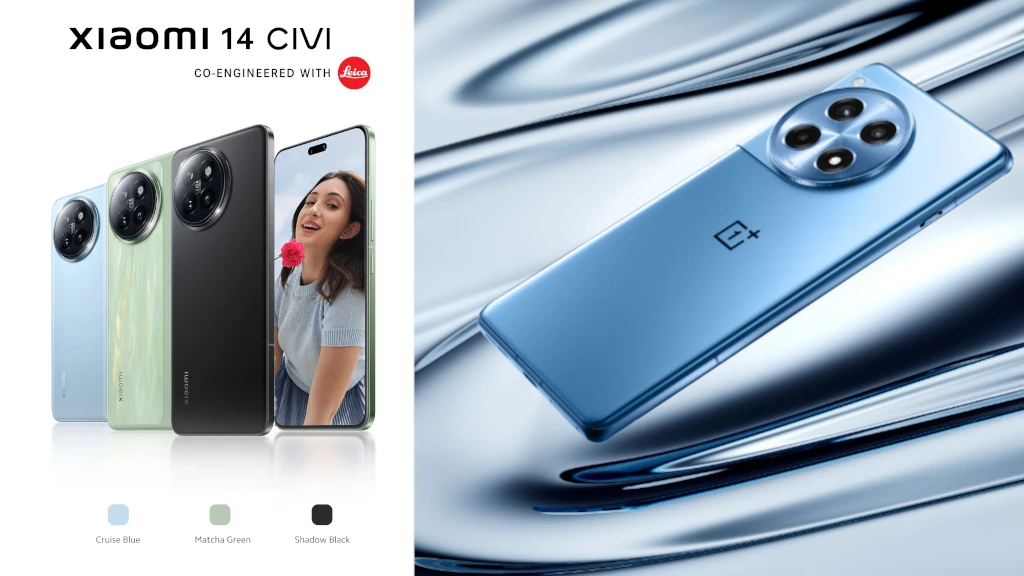Xiaomi has recently introduced the Xiaomi 14 Civi smartphone in India, a much-anticipated rebrand of the Chinese Xiaomi Civi 4 Pro. This device, loaded with appealing features, starts at under ₹40,000 (~$479), positioning it as a direct competitor to the OnePlus 12R. If you’re considering purchasing one of these models, here’s an in-depth comparison to help you decide which device is the better choice for you.

Table of Contents
1. Desing & display
Both the Xiaomi 14 Civi and the OnePlus 12R showcase sleek back designs with prominent circular camera modules positioned at the top left. The OnePlus 12R features curved sides, whereas the Xiaomi 14 Civi has flat sides. In terms of thickness, the OnePlus 12R is relatively bulky at 8.8mm, while the Xiaomi 14 Civi boasts a slim profile at just 7.45mm. It is worth pointing out that Xiaomi has provided a vegan leather back option in the form of its Matcha Green color variant, which makes the phone a bit thicker compared to its glass back variants.
Moving to the front of the device, the OnePlus 12R comes with a curved display, while the Xiaomi has something called a quad curve display that is essentially a flat display with the looks of a curved display. As for specifications, the 12R features a 6.78-inch AMOLED panel with Gorilla Glass Victus 2 protection, a resolution of 1.5K, a 120Hz refresh rate, and up to 4,500 nits of brightness. The Xiaomi 14 Civi has a 6.55-inch AMOLED panel with a similar resolution, refresh rate, and Corning Gorilla Glass Victus 2 protection. Both devices offer HDR10+ support and Dolby Vision.
2. Performance
In terms of performance, the OnePlus 12R features the Snapdragon 8 Gen 2 processor paired with LPDDR5X RAM. On paper, this processor outperforms the Snapdragon 8s Gen 3 chip used in the 14 CIVI, particularly in GPU capabilities, which should result in better gaming performance. However, the OnePlus 12R is known to have thermal issues that can cause FPS drops while gaming.
Conversely, the 14 CIVI boasts decent thermal management, meaning you’re essentially trading raw power for stability. It is capable of running games like BGMI at stable 60FPS, however, the device is yet to receive 90FPS support, which the OnePlus 12R already has.
The 14 Civi also has another advantage over the OnePlus 12R, which is its storage type. The Xiaomi device comes with UFS 4.0 storage, while the OnePlus 12R uses UFS 3.1 storage. You won’t see any noticeable differences between them in day-to-day work like opening apps and files. However, if you plan to transfer data to or from the device, the 14 Civi will be noticeably faster.
3. Battery and fast charging
Battery is one area where the OnePlus 12R is visibly superior to the 14 Civi. It features a large 5,500 mAh battery that comes with 100W fast charging. It is capable of charging from 1%-100% in just 26 minutes.
The Civi 14 on the other hand comes with a 4,700 mAh battery, paired with 67W fast charging. The brand claims that the device can go from 1-100% in 40 minutes of charging.
That said, the OnePlus 12R with a healthy battery usually averages around 7 hours of screen-on time, while with the 14 Civi, you can easily cross 8 hours of screen-on time.
4. Camera
The Xiaomi 14 Civi focuses on camera capabilities, especially for selfies. This model includes a dual front camera setup with two 32 MP sensors. The main selfie sensor has an f/2.0 aperture and a 78° field of view (FOV), while the second sensor has an f/2.4 aperture and a 100° FOV for ultra-wide shots. The front cameras can record in 4K at 30FPS. The camera app offers a teleprompter feature which can be useful to vloggers.
The rear camera setup is also notable, featuring Omnivision’s 50 MP Light Hunter 800 sensor with optical image stabilization (OIS). It is paired with a 12 MP ultra-wide camera and a 50 MP 2x telephoto camera. These cameras are tuned by Leica, and the primary camera uses a Leica Summilux lens.
On the other hand, the OnePlus 12R features a 50 MP Sony IMX890 primary sensor with OIS. This sensor, although older, still provides high-quality images and currently performs better than the Light Hunter 800 sensor on the 14 Civi. However, the final assessment of the primary cameras will depend on future updates from Xiaomi. That said, the remaining three camera sensors on the 12R, which include the 8 MP ultra-wide, the 2 MP macro, and the 16 MP front unit are outmatched by the 14 Civi.
5. Software
The Xiaomi 14 Civi runs on the new Android 14-based HyperOS, which features smooth animations, a clean UI, and customizable lock screens. Although the device has some bloatware pre-installed, it does come with features like Glance for Mi that some users might not prefer, but these can be turned off. On the other hand, OnePlus has an advantage here as its operating system doesn’t include bloatware or adware. Moreover, OnePlus has recently released updates that improve animations and add useful features and UI changes.
6. Verdict
The newly launched Xiaomi 14 Civi offers an attractive design, a good display, and a powerful yet efficient processor. While the primary camera could use some polish, it still provides a well-rounded camera setup. If you’re looking for a phone with a strong focus on selfies and a balanced camera system, the 14 Civi is a good option.
However, if you value performance, fast charging, and a clean software experience, the OnePlus 12 might be more suitable for you.
The Xiaomi 14 Civi has a starting price of ₹39,999 for the 8GB + 256GB variant, while the 12GB + 512GB version costs ₹44,999. It will be available from June 20 in Crusie Blue, Matcha Green, and Shadow Black colors.
The OnePlus 12R on the other hand has a starting price of ₹39,998 (8GB RAM + 128GB Storage) with additional offers. The 8GB + 256GB and 16GB + 256GB cost ₹42,999 and ₹45,999, respectively.









